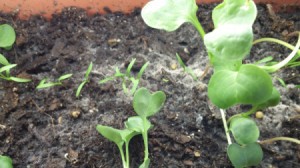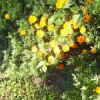 I have planted radish and carrot seeds in a trough planter. I am growing them indoors using a grow light. I have use homemade compost and Miracle Grow Moisture Control potting mix. The seedlings have sprouted, but there is a white substance growing on the soil. Is this a fungus? I have been using a spray fungicide, but it continues to grow.
I have planted radish and carrot seeds in a trough planter. I am growing them indoors using a grow light. I have use homemade compost and Miracle Grow Moisture Control potting mix. The seedlings have sprouted, but there is a white substance growing on the soil. Is this a fungus? I have been using a spray fungicide, but it continues to grow.
Any idea what it is or what I should do about it?
Thank you.
Three things that come to mind are, water a little less, provide more light if you can, and maybe most important is providing adequate ventilation. If you have a small, personal fan, you could use it to keep a bit of air flow around the plants. This may help more than a fungicide.
Some growers claim a thin layer of milled sphagnum on the surface of the soil will help keep fungi to a minimum. For me, it just caused the fungus to flourish.
If you lose the plants and start over, it may be a good idea to heat treat your soil in a microwave or oven. It should be made to steam and then cooled.
Thank you. I really appreciate your advice. Happy Holidays!
Are you using tap water? This can produce a white sort of crust. Rain water is better if you can collect it.
Marg frrom England.
Here are the questions asked by community members. Read on to see the answers provided by the ThriftyFun community.
What vegetables can you grow in your house in the winter?
By miranda robinson from Whitesville, WV

If you are going to grow indoor vegetables in winter, you will need to start by raising plants from seed in late summer or early fall. It's best to buy your seeds in the spring if you wish to do this, because it is not always easy to find seeds for sale at local garden centers in the fall.
Use a light seedling mix for starting your seeds. Its loose consistency will make it easy for the plants new roots to start to develop. After the seedlings have two true leaves, you can begin to carefully transplant them into individual four-inch containers. You can use any good potting soil for this purpose, but do not use regular garden soil. It is usually very heavy, has poor drainage and can also harbor disease and insects that can kill your new starts.
Because you will be watering these plants every day or every other day to keep the roots properly moist, you are also washing nutrients out of the soil. So feed your plants with a complete organic fertilizer every couple of weeks to give them the food they need to grow and flourish.
You will be playing with temperatures when raising indoor vegetables to suit the particular plants you wish to grow. Some vegetables, such as lettuce, endive, and radishes like cooler indoor temperatures. Daytime temperatures in the 60s work well, while night temperatures should go no lower than the 40s. A basement situation might work well to provide these temperatures, or an unheated porch if it doesn't get too cold.

Herbs which will grow indoors:
Basil
Oregano
Mint
Parsley
Rosemary
Sage
Thyme
Angelica
Chamomile
Dill
Fennel
Lavender
Geranium
Chives
Good luck.
 How can I use Herbalife canisters to create an indoor garden in a small space? I have a large window approximately 27 1/2 inches high, and 46 1/2 wide in my kitchen that I would like to block and let light in at the same time. At the same time I want to grow my own food without spending a lot of money. I am trying to incorporate the concept of using a non-electric watering system so I could leave my plants for a week without worry.
How can I use Herbalife canisters to create an indoor garden in a small space? I have a large window approximately 27 1/2 inches high, and 46 1/2 wide in my kitchen that I would like to block and let light in at the same time. At the same time I want to grow my own food without spending a lot of money. I am trying to incorporate the concept of using a non-electric watering system so I could leave my plants for a week without worry.
By Laurel M.
Can I use Essick Air humidifier treatment in my humidifier for growing vegetables inside in the winter months? Would it be harmful to my plants or myself?
By Doug W.